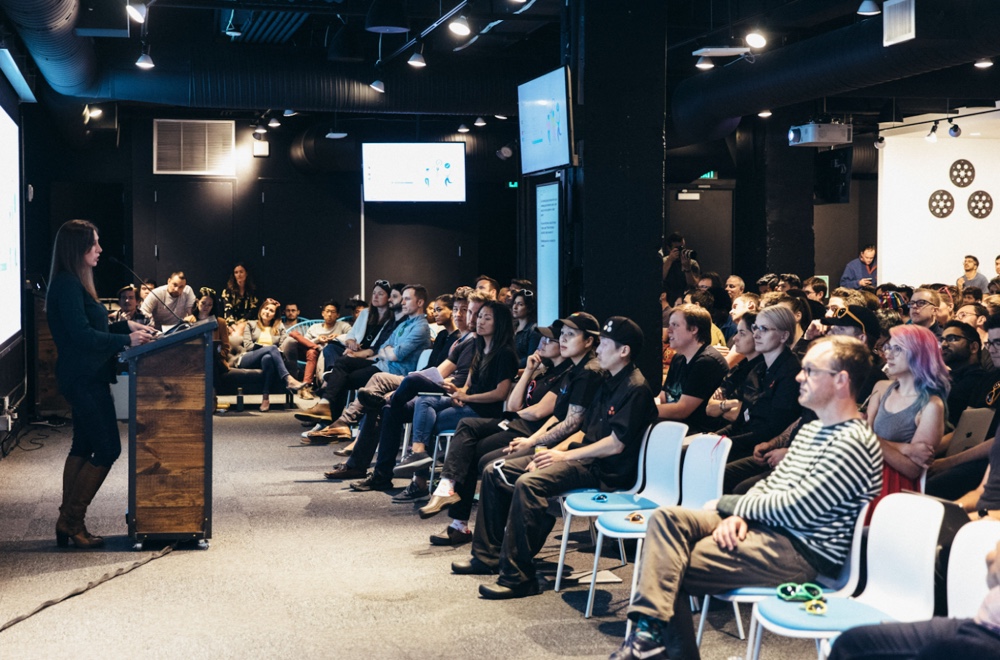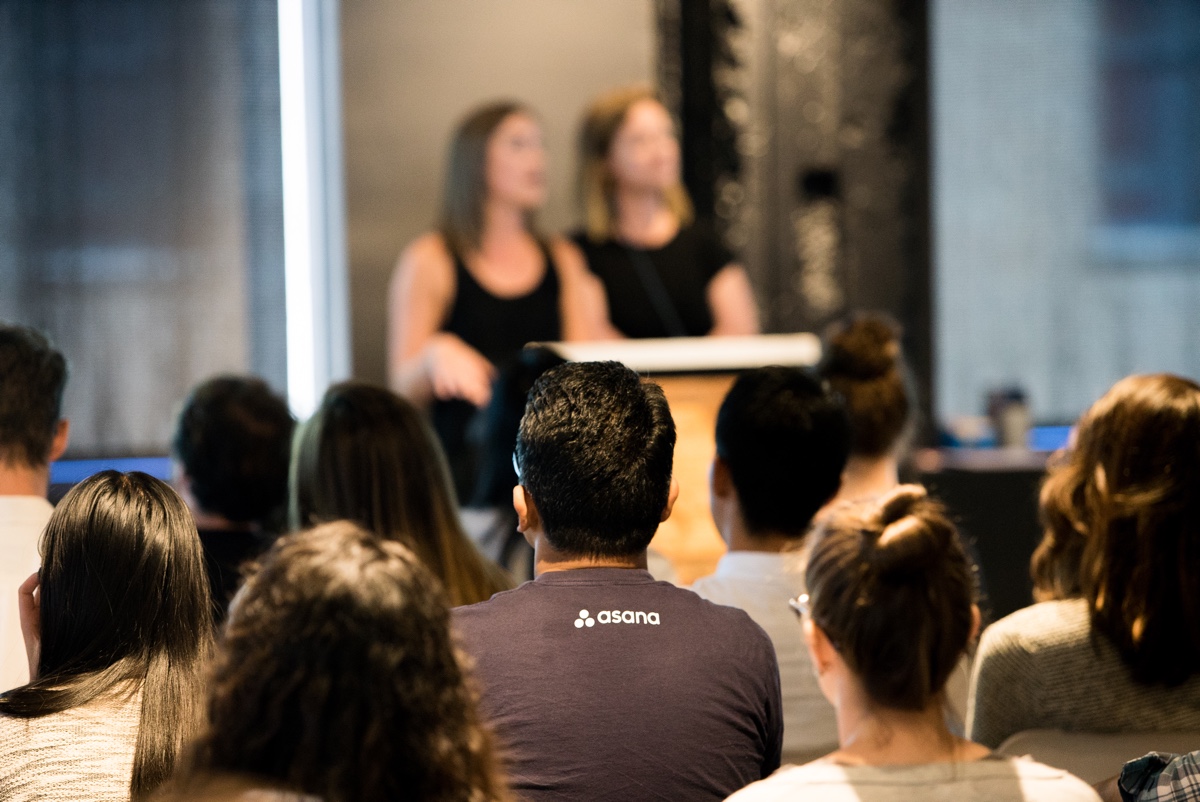-
Committed to Personal Growth
We believe all engineers should have self-driven mindsets – regardless of experience level.
Maintaining a learning, self-driven mindset is crucial to being a good engineer – whether you're new or have 10+ years of experience. When you join a new company, you will be working in an unfamiliar codebase. Once you settle in, you’ll be solving problems that don’t yet have solutions.
When you become an Asana engineer, you’re paired with an onboarding mentor, who will make sure you can ramp up quickly. You’ll have responsibility for your own growth and be empowered to become a better engineer.
At Asana, engineers encourage each other to continually look for new areas of expertise for growth and development. Opportunities like our quarterly hackathons allow you to jump into unfamiliar parts of the codebase, work with new people, and learn new skills.
We want to challenge you to do great things, fast and will support your unique areas of growth.
We’re in a phase of fast growth where change is a constant and every day brings new problems to solve and new opportunities for you to make an impact. Your manager, colleagues, and leaders will trust you to move work forward, make decisions, and drive impact.
Since we believe career growth isn’t linear, and that everyone has a unique path, our programs are inherently designed to support multiple directions and areas of growth. Our goal is to have a supportive environment that challenges you to do great things, fast, while practicing mindfulness as we grow and scale. In turn, we see this as the best way to set you up for success.
Here are some of the ways we ensure that every Asana engineer is constantly learning and growing:
- Constant new opportunities: Asana is growing quickly, so we constantly need people to take on new responsibilities, with support of their peers and other engineering leaders. When a new opportunity becomes available, we make sure every engineer knows about it and has a chance to apply.
- Open engineering culture: The Asana product makes it easy to share information and collaborate, and our engineering culture aspires to do the same. Engineers on different teams have many opportunities to work together, and internal transfers are encouraged.
- Areas of Responsibility: Every employee at Asana is empowered to take on big responsibilities that directly impact our success as a company. Areas of Responsibility (AoRs) are distributed among the greater team, and allow individuals to take on projects and initiatives they’re passionate about that might otherwise be outside of their typical day-to-day.
- Mentorship embedded in our culture: You’ll have a mentor by your side to guide you through the onboarding process from day one. Our Engineering team pairs every team member with a mentor throughout their Asana journey to help them navigate their growth and development.
- Free executive and life coaching: Every employee can choose from experienced, professional coaches and get six free sessions per year, or nine sessions for people managers.
- Mental health benefits: Asana cares deeply about you and wants to support you and your family through any work- or life-related stressors. You will have access to a platform that provides sessions with certified coaches and therapists as well as digital programming and audio therapy.
- Conscious Leadership Group training: Conscious Leadership provides us with a shared language and philosophy around how we as individuals show up to work every day. All Asana team members are invited to participate in CLG training.
- Manager training programs: Investing in managers is critical to supporting every employee’s growth and development. Managers have access to Outstanding Manager Bootcamp courses year-round, as well as several guides and resources, to ensure they are building their leadership skills and setting their team up for success.
- Open source: Engineers at Asana have been contributing to open-source software since the company was founded. Our community of Engineers are focused on fostering constant co-creation and collaboration.

-
Fosters Psychological Safety
By creating a culture of transparency and trust, we foster psychological safety and an inclusive mindset within our company and product.
At Asana, teaching with compassion means sharing your knowledge and realizing the strength that comes with empowering your teammates. It’s not about making someone feel inferior for not knowing what you know, but rather giving them the patience they need to make progress. To do this, we strive to understand from the learner’s perspective: where they come from, what their learning style is, and how they absorb information.
We place a huge emphasis on mentorship. Everyone has unique knowledge, skills, and experience, which they can share with others. From onboarding buddies, to managers, to interview mentors, we look for every opportunity to create meaningful relationships. We’re mentoring each other all the time – there’s always room to grow!
Ultimately, we view failure as a crucial step toward success and an opportunity to learn. When things don’t go as expected, we practice an exercise called “Five Whys,” which encourages us to analyze a problem with a curious mindset without blame.

-
High Quality Code Base
Making things simpler is always our goal – for ourselves and our customers.
We strive for simplicity. When contributing code, Asana engineers always ask the question, “Could this be simpler?” Striving for the simplest, most viable solution requires time and effort up front, but it always pays off in the long-run.
Simple solutions are easier to understand, especially as our codebase grows, and engineers often spend more time reading than writing code. Having code that’s easy to reason about enables them to spot bugs faster and make modifications with confidence.
By reducing complexity, our team is able to create a more reliable, maintainable, and testable application, and therefore a better experience for our users.

-
Product-Driven
As a product-led company, we value clarity for ourselves and our customers.
Building products at a product-led company allows us to work closely with our Product, Design, Data Science, Data Engineering, and User Research teams, and we work hand-in-hand throughout the entire product development process.
Deep in Asana’s essence is clarity: we serve to give teams clarity into their work, and we do this by getting clarity about our own work.
At Asana, every non-trivial project starts with a design. Engineers share designs through Asana projects to allow each other to engage in discussions and ask questions. They share learnings and patterns, and use these to jump-start plans for future projects.
Articulating our mental model helps ensure we understand the logic of our ideas. It enables us to iterate faster than we can through writing and rewriting code. Once we agree on what we’re doing, we can execute without needing to regularly check that what we’re building still makes sense.

-
Continuous Delivery
We ship fast and sustainably.
Shipping code is the most visible way that engineers contribute to the success of Asana, and doing so in a fast and sustainable way is key.
Shipping fast starts with serious investment in tooling, such as continuous deployment with multiple pushes per day. It also takes focus and flow, like the kind you can have during our “No Meeting Wednesdays.”
But shipping fast and sustainably takes more than just effective work. When we’re focused, we write higher-quality code, and this translates to less technical debt, faster iteration, and less time fighting fires. While lots of hours in the office lead to the illusion of a lot of work, it often results in just a lot of energy spent treading water.
This is a long-term investment against the pervasive misconception that shipping fast means working unsustainably. Software isn’t going anywhere, and Asana’s engineering culture aims to support people to work well for decades to come.
-
Actively Practices Inclusion
We celebrate and support our individual identities. In order to do our best work everyone must feel respected, valued, and that they belong.
Here are several ways Asana engineers practice inclusivity and build community:
- Employee Resource Groups foster trusted, safe spaces for underrepresented groups and allies. Our thriving communities include AsanaWomen, Asanapac, Blacsana, Team Rainbow for LGBTQIA+ Asanas, Raíz for Latine/Latinx Asanas,and Gradient for Asanas of color.
- Gigabytes is our growing community of women, transgender, and gender non-conforming individuals in technical roles.
- Ask Me Anything sessions with members of our leadership team and external thought leaders forge connections and bring unique perspectives to the table.
- The Real Talk event series promotes candid, open conversations. Asanas come together to discuss important, often uncomfortable topics, such as experiences around identity and workplace challenges.
- Organized group learning programs like book clubs, learning talks, and movie screenings provide ways for every Asana to build community and connection.
- Gender-inclusive spaces: From gender-neutral restrooms in every office, to pronoun fields in our product, we recognize and embrace all identities.

-
Rapidly Growing Team
Asana Engineering spans four offices around the world and we’re continuing to grow quickly! Here’s what you need to know about each of our locations and our teams:
- San Francisco is our headquarters and all product engineering pillars are represented here.
- New York is where we first branched out into having a distributed engineering team, and it’s now home to our second-largest engineering team globally. Our New York team works mostly within the Clarity pillar, launching product features like Timeline and Workload.
- Reykjavik is our first international engineering office, home to engineers on our Infrastructure team. The Reykjavik team supports the maintenance, security, and scale of our core infrastructure that powers Asana, like LunaDB stability, and also works on the internationalization of our product.
- Vancouver opened earlier this year and is growing quickly, with Asanas in Product Engineering and Data Science who work in our Adoption pillar. The Vancouver team is focused on building features that support revenue growth and in-product education.
Our teams:
- Product Engineering: Builds the Asana web and mobile application using a customer-driven approach to iterate and evolve our product to meet the needs of teams everywhere. We structure work in Product Engineering into three pillars:
- Workflow pillar: Makes the right connection between our customers, their tools, and their processes; builds features that support our customers’ unique workflows. Supports developers worldwide who use the Asana API.
- Clarity pillar: Delivers the pyramid of clarity to our customers; builds features to ensure that teams have clarity of purpose, plan, and responsibility, which we know makes them more productive.
- Adoption pillar: Increases the adoption and monetization of Asana; builds features that make it easy for users to quickly see value from the moment they start using Asana.
- Infrastructure and Security: Builds the foundation needed to support our web and mobile applications and our API, as well as the systems and tools that enable Asana to easily build secure software.
- Data: Designs and uses data analysis tools that increase our data’s scalability, accuracy, and accessibility; act as key partners to each product team to ensure we have the right metrics and insights in place.